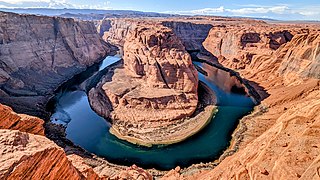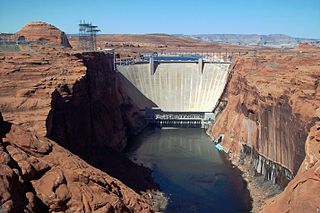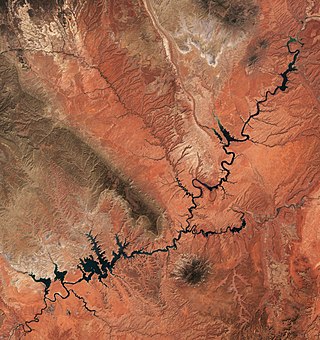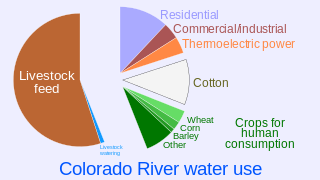
The Colorado River is one of the principal rivers in the Southwestern United States and in northern Mexico. The 1,450-mile-long (2,330 km) river, the 5th longest in the United States, drains an expansive, arid watershed that encompasses parts of seven U.S. states and two Mexican states. The name Colorado derives from the Spanish language for "colored reddish" due to its heavy silt load. Starting in the central Rocky Mountains of Colorado, it flows generally southwest across the Colorado Plateau and through the Grand Canyon before reaching Lake Mead on the Arizona–Nevada border, where it turns south toward the international border. After entering Mexico, the Colorado approaches the mostly dry Colorado River Delta at the tip of the Gulf of California between Baja California and Sonora.

Glen Canyon Dam is a concrete arch-gravity dam in the southwestern United States, located on the Colorado River in northern Arizona, near the city of Page. The 710-foot-high (220 m) dam was built by the Bureau of Reclamation (USBR) from 1956 to 1966 and forms Lake Powell, one of the largest man-made reservoirs in the U.S. with a capacity of more than 25 million acre-feet (31 km3). The dam is named for Glen Canyon, a series of deep sandstone gorges now flooded by the reservoir; Lake Powell is named for John Wesley Powell, who in 1869 led the first expedition to traverse the Colorado River's Grand Canyon by boat.

Lake Powell is an artificial reservoir on the Colorado River in Utah and Arizona, United States. It is a major vacation destination visited by approximately two million people every year. It is the second largest artificial reservoir by maximum water capacity in the United States behind Lake Mead, storing 24,322,000 acre-feet (3.0001×1010 m3) of water when full. However, Lake Mead has fallen below Lake Powell in size several times during the 21st century in terms of volume of water, depth and surface area.
In the American legal system, prior appropriation water rights is the doctrine that the first person to take a quantity of water from a water source for "beneficial use" has the right to continue to use that quantity of water for that purpose. Subsequent users can take the remaining water for their own use if they do not impinge on the rights of previous users. The doctrine is sometimes summarized, "first in time, first in right".

The Colorado River Compact is a 1922 agreement that regulates water distribution among seven states in the southwestern United States. The contract is about the area within the drainage basin of the Colorado River.

Parker Dam is a concrete arch-gravity dam that crosses the Colorado River 155 miles (249 km) downstream of Hoover Dam. Built between 1934 and 1938 by the Bureau of Reclamation, it is 320 feet (98 m) high, 235 feet (72 m) of which are below the riverbed (the deep excavation was necessary in order to reach the bedrock on which the foundation of the dam was built), making it the deepest dam in the world. The portion of the dam above the foundation stands 85 feet (25.9 m) tall, making it the only dam in the world that stands more underground than above ground. The dam's primary functions are to create a reservoir, and to generate hydroelectric power. The reservoir behind the dam is called Lake Havasu and can store 647,000 acre⋅ft (798,000,000 m3; 2.11×1011 US gal; 1.76×1011 imp gal). The dam straddles the Arizona-California state border at the narrows the river passes through between the Whipple Mountains in San Bernardino County, California and the Buckskin Mountains in La Paz County, Arizona.

The International Boundary and Water Commission is an international body created by the United States and Mexico in 1889 to apply the rules for determining the location of their international boundary when meandering rivers transferred tracts of land from one bank to the other, as established under the Convention of November 12, 1884.
Kansas v. Colorado is a longstanding litigation before the Supreme Court of the United States between US states: Kansas and Colorado regarding the payment for the use of the Arkansas River. The Court has rendered numerous opinions on the case:
Wyoming v. Colorado, 259 U.S. 419 (1922) is a set of court cases, all dealing with water distribution from the Laramie River. A petition for rehearing was granted, which revised the original decision. A motion to dismiss was later denied.

The Colorado River Storage Project is a United States Bureau of Reclamation project designed to oversee the development of the upper basin of the Colorado River. The project provides hydroelectric power, flood control and water storage for participating states along the upper portion of the Colorado River and its major tributaries.

California's interconnected water system serves almost 40 million people and irrigates over 5,680,000 acres (2,300,000 ha) of farmland. As the world's largest, most productive, and potentially most controversial water system, it manages over 40 million acre-feet (49 km3) of water per year. Use of available water averages 50% environmental, 40% agricultural and 10% urban, though this varies considerably by region and between wet and dry years. In wet years, "environmental" water averages 61%, while in dry years it averages 41%, and can be even lower in critically dry years.
Winters v. United States, 207 U.S. 564 (1908), was a United States Supreme Court case clarifying water rights of American Indian reservations. This doctrine was meant to clearly define the water rights of indigenous people in cases where the rights were not clear. The case was first argued on October 24, 1907, and a decision was reached January 6, 1908. This case set the standards for the United States government to acknowledge the vitality of indigenous water rights, and how rights to the water relate to the continuing survival and self-sufficiency of indigenous people.

The Klamath Diversion was a federal water project proposed by the U.S. Bureau of Reclamation in the 1950s. It would have diverted the Klamath River in Northern California to the more arid central and southern parts of that state. It would relieve irrigation water demand and groundwater overdraft in the Central Valley and boost the water supply for Southern California. Through the latter it would allow for other Southwestern states—Arizona, Nevada, New Mexico and Utah—as well as Mexico to receive an increased share of the waters of the Colorado River.

Water law in the United States refers to the Water resources law laws regulating water as a resource in the United States. Beyond issues common to all jurisdictions attempting to regulate water's uses, water law in the United States must contend with:

Water in Colorado is of significant importance, as the American state of Colorado is the 7th-driest state in America. As result, water rights generate conflict, with many water lawyers in the state.
Virginia v. Maryland, 540 U.S. 56 (2003), is a case in which the Supreme Court of the United States settled a dispute between the Commonwealth of Virginia and the State of Maryland regarding Virginia's riparian rights to the Potomac River. The Supreme Court held in a 7—2 decision that Maryland has no legal authority to regulate or prohibit Virginia and its political subdivisions from building and improving structures in the river and from drawing water from the river. The decision drew heavily on the Maryland–Virginia Compact of 1785, an agreement between the two states concerning navigational and riparian water rights along the Potomac River.
The Montana Water Court is a court of law in the U.S. state of Montana which has jurisdiction over the adjudication of water rights. The filing, verification, recording, and enforcement of water rights in the Montana Territory and, later, the state of Montana were considered highly inadequate until 1972, when a new state constitution required a more robust, highly centralized water rights legal system. Implementation of this system led to the establishment of the Water Court in 1979, after six years of mixed success with an administrative solution. The Water Court consists of a Chief Water Judge, Associate Water Judge, and four District Water Judges, but most work is handled by special masters. The process of identifying, verifying, and adjudicating water rights is a complex one, and budgetary and personnel issues have slowed the work at times. Appeals from the Water Court are made directly to the Montana Supreme Court.
Texas v. New Mexico and Colorado, 583 U.S. ___ (2018), was a Supreme Court case argued and decided during the 2017 term of the Supreme Court of the United States. The case involved an interstate dispute regarding New Mexico's compliance with the Rio Grande Compact of 1938, an agreement which established a plan for equitable apportionment of the water in the Rio Grande Basin among the states of Colorado, New Mexico, and Texas. The Court considered the question of whether the U.S. federal government had a legal right to join litigation against New Mexico; the Court ruled that the federal government was within its rights when it did so.
Texas v. New Mexico, 592 U.S. ___ (2020), is a long-running United States Supreme Court case between the U.S. states of Texas and New Mexico regarding the Pecos River Compact. It was decided on December 14, 2020.















